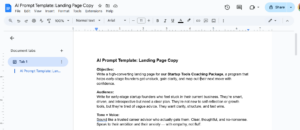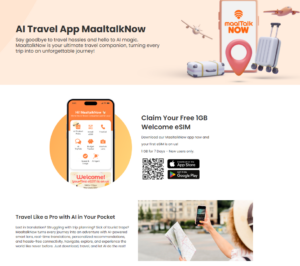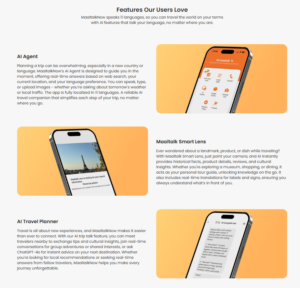If you’ve handed off content to AI without a strategy, you’ve probably noticed that your marketing copy sounds polished … but awfully generic.
That’s because AI is only as good as the prompter behind it. To create consistent brand messaging with AI writing tools, you need to put in some elbow grease. (Spoiler alert: Yes, we still need the humans.)
That said, I’d love to share some of my top tips for achieving Consistent Brand Messaging with AI Writing Tools. Grab a notebook and a pen, and let’s get started.
1. Train AI to understand your brand identity and communication channels
Your brand is a whole personality. It houses perspectives, a set of values, rhythms, and non-negotiables.
AI doesn’t know any of that out of the box.
If you want consistent messaging, you need to train your AI tools to think like your brand.
How?
I recommend creating a Scope of Process (SOP) document that breaks down your brand’s core identity and the inputs required to create aligned marketing content. (Both your writing team members and your AI tools will need these for each of your marketing channels.) This is a key step towards achieving Consistent Brand Messaging with AI Writing Tools.
Call them “AI Style Guides” or “AI Writing SOPs.”
But before handing them off, test your guides to make sure your tools are generating the messaging you’re looking for. After testing, upload them to your internal communications tool or remote work software, whichever system your team uses to collaborate on content.

At minimum, these should include:
- Visual tone matching, if your AI writes captions for visual content, your playful product photos won’t pair well with stiff or formal copy.
- Content hierarchy, like how you introduce problems before pitching solutions or how you structure a social proof section.
- Voice guidelines with real examples (actual sentences that show what “confident but conversational” and other tones sound like).
- Phrasing preferences, such as how you specifically refer to your product, customers, or competitors.
- Specific writing prompts for each channel to direct the AI. (More on this below.)
Be sure to also include your SEO guidelines, publishing guidelines, and image guidelines, so everything is in one spot. Add a note about your AI image policy here, too. For instance, you might give the okay to use AI headshots generated with tools like Depositphotos, or specify that only real images should be used for certain content types, like team pages or case studies.
Shoot a training video for your team as well. Use Loom or a screenshot tool and add it to your SOPs. Alternatively, host a virtual training day to ensure everyone is on the same page before you begin using your SOPs.
As you continue reading my tips, you’ll notice that AI writing training in some form is probably a good idea.
2. Create prompt templates for Consistent Brand Messaging with AI Writing Tools
AI gives you what you ask for. (Or at least it tries to.)
If your team constantly types freeform prompts, your output will drift. Templates eliminate the guesswork of back-and-forth prompting and promote consistency in messaging.

(Image created and provided by Ioana)
For every major content type, create a prompt template that includes:
- Keyword guidelines. For instance, “Include the main keyword in at least two H2s and two secondary keywords in two other H2s. (Make sure your team has access to your keyword research tool so they can pull terms to help meet your guidelines.)
- Audience clarity. For instance, “Write for early-stage founders looking to validate a product idea fast.” Differentiate your audience segments here as well.
- Structural guidance such as “Start with a short story, then break into three sections with skimmable subheads.”
- Stylistic rules such as “Avoid all caps, emojis, or exclamation points unless quoting users.”
- Call-to-action style, like “Use clear, benefit-focused CTAs with urgency tactics.”
- Tone anchors like “Sound like a trusted advisor with a sense of humor.”
Have team members copy these templates, edit them as needed, and paste the edited prompts into their AI writing tools.
Remind them to share your SOPs with the AI, too. (With your SOPs and prompts, your AI tools and teams will always have the guidelines they need to promote consistency in messaging.)
There’s a caveat here, though.
Ensure team members don’t copy the first AI-generated text they receive and paste it directly for publication. Keep reading to learn more.
3. Be patient with your AI writing tools
AI can speed things up, but it still takes some back-and-forth to get messaging that feels right. Even if your writing team is using a solid prompt and SOP, they’ll likely need to tweak, refine, and request changes. That’s a normal part of the creative process with AI.
Make sure your team knows this! Inform them that the generated text may not accurately reflect your brand voice on the first attempt. Ask them to be patient upfront so the output aligns with your tone and style as much as possible.
But even when your writers are patient, they’ll likely still pass along text that needs a bit more editing.
This is where your human editors come in.
4. Set the right expectations: You’ll still need to edit
AI is great for beating writer’s block or brainstorming ideas. But you’ll still need the human touch before you hit publish, especially for high-stakes assets or nuanced industries.
So, I recommend creating another SOP. One that your editors can use to polish and rework generated content as needed to meet your guidelines.
Here’s what your Editing SOP should include:
- Voice realignment: AI may hit the right message but the wrong tone. In your SOP, explain how to edit the generated text so it reflects your brand voice.
- Insight injection: Tell editors to add product-specific language, industry references, or a personal perspective that AI wouldn’t know to include.
- Fluff trimming: Many AI models overwrite by default. Make a note about editing out filler words and pointless explanations.
- CTA sharpening: Replace soft asks, like “Check out our site”, with action-driven CTAs that reflect the customer journey.
Editing is where the generic becomes specific. And the specific is what creates resonance with your target audience. Again, it’s a collaboration.
5. Use top-performing content as context
One of the most overlooked strategies for improving brand consistency is feeding AI your own top-performing content.
If you think about it, it’s pretty genius.
You’re showing AI what your voice sounds like with published links, attachments, and copied samples to give it a track record to mimic.
I recommend taking a look at your website, landing pages, and blog posts. Which pages and pieces reflect your brand voice and goals the most? You can copy and paste these into AI and tell it to use them for context when generating your text.
For instance, Maaltalk could use its AI travel app page as an example of brand-approved content. The page covers answers to frequently asked questions (FAQs), top features, and how to download the app.
Here’s what it looks like:


And Cruise America could use its RV rentals in San Francisco page as an example of brand-approved content. Similar to Maaltalk, it has an FAQ section and a features overview. It also includes trip inspiration guides and a San Francisco travel overview that highlights key attractions, day trips, and nearby destinations.
Their voice is friendly, adventurous, and approachable, mirroring the freedom of road trips. This consistent tone appears in everything from website copy to email newsletters and social posts, ensuring customers feel the same vibe at every touchpoint. A well-documented brand voice guide makes this alignment possible, even when using AI tools. It also plays a big role in maintaining Consistent Brand Messaging with AI Writing Tools.

Both of these pages contain sufficient examples for AI to identify patterns and follow the style.
Here’s how to systematize this approach to save valuable time:
- Tag your highest-performing copy across formats. Review your landing pages, nurture emails, paid ads, and other marketing materials.
- Ask AI to highlight specific phrases or CTAs it notices across your best-performing content.
- Create a swipe file your team can pull from and reference in prompts (e.g., “Write something like this: [insert sample] but focused on [new product]”)
Over time, this turns your AI from a blank-slate generator into a pattern recognizer.
6. Audit your AI outputs like you audit your marketing campaigns
Set a recurring checkpoint (like monthly or quarterly) to review the AI-generated content your team publishes. Pull a sample set from every active channel, compare it across formats, and identify any gaps.
Here’s a mini checklist you can use during your audit:
- Content cannibalization: Is AI accidentally rewriting the same concept multiple ways without adding value?
- Cliche phrases: Does your copy have any cliche AI phrases, like “fast-paced digital landscape”?
- Message stacking: Are you keeping your main points clear, or are you all over the place?
- CTA cohesion: Are your calls to action aligned across your homepage, ads, and blog posts?
- Tone drift: Does your social copy still match the tone of your onboarding emails?
If you find gaps, review your SOPs and prompts. Are the prompts misaligned? Is the brand voice guide outdated? Are editors skipping review steps?
Document what’s working, flag what’s not, and use the audit to improve your templates and inputs.
7. Set guardrails for compliance and ethics
AI speed can backfire in industries where accuracy, compliance, and trust are non-negotiable. (Like in finance or health.)
Make sure your content team has AI-specific rules around:
- Tone sensitivity: Are there situations (e.g., crisis communication or mental health topics) where AI tone must be adjusted or human-written?
- Disclosure policies: Will you reveal when content was AI-assisted? If so, how and where?
- Factual verification: Who fact-checks AI-written claims, statistics, or health guidance?
- Data usage: What internal data can AI reference and what’s off-limits?
Take a look at the blog post below titled “Abacus Global Management Reports First Quarter Results:”

If the team at Abacus Global relied entirely on AI to draft it, there’s a risk of misquoting financial data — something no firm can afford.
Brands in low-risk sectors need a position here, too. Trust compounds over time, and even one careless AI error can damage it.
Want a pro-tip? Designate someone on your content team as the “AI Ethics” go-to person. This gives your team a resource they can contact if they ever feel iffy about AI-generated text. (Just make sure they’re well-versed in AI best practices, legal concerns, and your brand values.)
8. Use AI to repurpose your best content
AI doesn’t need to create something brand new every time.
If you already have content that performs well and meets your voice guidelines, have your team use AI to repurpose it across your marketing channels. The goal is more value from content that’s already working.
For example, if a blog post drives leads, use AI to:
- Pull key phrases to use as calls to action on landing pages
- Repurpose it into a series of emails
- Turn sections into carousel posts
- Summarize it for short videos
If your founder shared strong quotes in an interview, AI can help turn those into LinkedIn posts, website copy, or investor materials.
For sales content, if an explainer page converts well, use AI to repurpose it into FAQs, email templates, or support articles, keeping the same tone and style.
Here’s a simple, practical checklist your content team can use to decide which pieces to repurpose:
Content repurposing checklist
Use this to test which content is worth repurposing quickly.
- Drives results?
➜ Does it bring in leads, traffic, signups, or engagement? - Still relevant?
➜ Is the info accurate and useful right now? - Matches your brand voice?
➜ Does it already sound like you? - Has clear takeaways?
➜ Are there quotes, stats, or sections that stand alone well? - Could perform well in another format?
➜ Could it be just as strong in another format like video, email, or social? - Tells a good story or shows impact?
➜ Is it memorable or persuasive enough to reuse? - Could help another team?
➜ Could sales, customer success, or recruiting use it too?
If you ticked all of these boxes for a content asset, it’s likely a good piece to repurpose!
(Feel free to adjust this checklist as you learn more about what to look for.)
Wrap up
Something I stand by is that AI isn’t here to be your brand. It’s here to support it. But it’ll only reflect the systems, values, and quality standards you build into it.
Want consistent, compelling messaging? Start upstream with clear brand voice training, tight templates, and human editing baked into your process. That’s how you make AI a brand asset, not a brand risk.
And if you’re looking for sharp AI writing tools you can train in minutes, not weeks, try Writecream. Start writing for free NOW.
FAQs
Why does consistent branding matter?
Consistent branding matters because it builds trust. When your brand looks, sounds, and feels the same everywhere, people remember you and they know what to expect.
How does consistent brand messaging affect customer loyalty?
Consistent brand messaging makes people feel more connected to you. When your message stays steady, customers are more likely to believe in your values and stick with you over time.
What are some ethical considerations when using AI-powered tools for writing?
Don’t use AI to copy others or mislead people and always review what it creates. (You’re still responsible for the message.)
Can I use AI tools to write social media content with a consistent brand voice?
Yes. You can train AI on your tone and key messages so your social media posts sound like they’re coming from you, not a robot.
What AI content creation tool works the best?
Writecream is one of the best for fast, on-brand content. It’s especially good for short-form writing like outreach emails, social posts, and ad copy — and it adapts to your voice quickly.
Should content marketers use AI tools to speed up their content workflow?
Absolutely — as long as they still edit for tone, accuracy, and strategy. AI helps you move faster, but your human insight keeps it sharp.
Can I train AI on my brand’s core identity for consistent messaging?
Yes. You can feed AI your tone guidelines, brand phrases, and past content. Over time, it learns to mimic your voice and stay consistent across formats.
